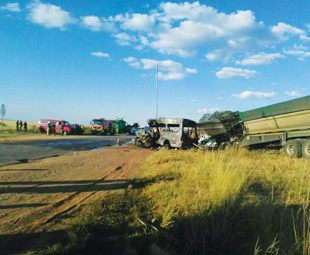Let’s do it for those 18 kids…

April 21 was just another day in the lives of millions of public transport users in South Africa, but for the families of 18 schoolchildren and two adults who died in the taxi inferno near Bronkhorstspruit, the memory of that day will never end
As an unscathed user of public transport for well over 60 years, my deepest sympathy goes out to those families.
To our shame, such tragedies have become commonplace in South Africa, but, to his credit, the Gauteng MEC for Education, Panyaza Lesufi, showed up on the same day and called it a “national disaster”.
A few days later the Minister of Transport, Joe Maswanganyi, accompanied by dignitaries such as Baleka Mbete and Edna Molewa, repeated similar sentiments (although they were also scolded for politicising the event). There was even a minute of silence.
This is not the time to have a dig at the taxi industry. It could have happened to anybody. In March 1985, 42 children drowned when a municipal bus drove into the Westdene dam in Johannesburg. Looking at an old photograph of the incident, an ominous portent of the 2017 disaster was that the bus carried a bright yellow advert for Lion Matches.
Do we have what it takes to stop these disasters? The evidence is not encouraging. I’d rather start with a dig at the VIP convoy system, and am willing to bet that the dignitaries who took part in the memorial service arrived in separate VIP convoys, probably consisting of more than two vehicles each, travelling way over the speed limit.
Each item of hardware making up these convoys probably costs as much as several classrooms for a school. The dozens of policemen making up the VIP units could also be fighting crime elsewhere.
Yes, I know that it is not the job of the South African Police Service to control traffic, but the VIP system has started a precedent. It would be interesting to see a class action court case testing the interpretation of the Road Traffic Act, which allows people engaged in “civil protection” to exceed the speed limit.
I would rather see a policeman (yes, perhaps only one will be necessary) on a motorcycle (yes, not even a car) escorting a convoy of Putco buses travelling on the M1 from Soweto to Sandton each weekday morning and the other way in the afternoon.
The same policeman (or woman) could even make two round trips during each peak period. We can pretend that there is a big conference in Sandton and that the president needs to get through. The cars could simply be muscled out of the way. If fully loaded minibus taxis want to join the bus convoy, they would be welcome.
That will go some way towards proving that we are serious about public transport.
As this column has repeatedly pointed out, poor transport arrangements are hurting the economy. It should be high on our radar, but isn’t. So, it comes as a mild surprise to read (Business Day, May 5) that the Competition Commission (CC) is planning to launch an inquiry into the subsidies paid to public transport. The project has apparently been triggered by complaints that Uber is being favoured in terms of transport regulation, but will go further:
The inquiry will be very big and complex and it is estimated that it will take about two years to complete.
It shouldn’t take that long. Then along comes a wobble:
The results of the inquiry would feed into the many transport plans being developed by spheres of government and drive the adoption of efficient public transport systems.
That’s a joke. What “transport plans” are they talking about? Gauteng certainly doesn’t have one! Fortunately, there may still be hope for the inquiry, which will also apparently look at the subsidies provided to buses and rail including the Gautrain.
I see this as a welcome slap in the face of the national Department of Transport. For years it has been wasting time with projects like the National Transport Master Plan, which has been no more than a job-creation exercise for armies of consultants and the printing industry.
However, I wonder whether the CC has the resources to do a proper job. Will it look at the subsidy paid to the motor assembly industry, which contributes to the underpricing of cars?
Will it also look at the low rate of tax on fuel, which leads to a perception of low costs on the part of car users? Fuel should cost around 50 cents more per litre. This would raise R10 billion, which alone would be enough to solve the minibus-taxi “problem”. These car subsidies are more than those paid to public transport.
If the CC does a good job, we can dedicate it to the memory of those 18 children who lost their lives on April 21.
Vaughan Mostert lectured on public transport issues at the University of Johannesburg for nearly thirty years. Through Hopping Off, Mostert leaves readers with some parting food for thought as he continues his push for change in the local public transport industry.
Published by
Focus on Transport
focusmagsa




 Big news from FOCUS on Transport + Logist
Big news from FOCUS on Transport + Logist


 !
Starting 1 April, every
!
Starting 1 April, every


 FUSO: Driving the Future of Mobile Healthc
FUSO: Driving the Future of Mobile Healthc



 A brand
A brand




 Wondering about the maximum legal load for a
Wondering about the maximum legal load for a 
 The MAN hTGX powered by a hydrogen combus
The MAN hTGX powered by a hydrogen combus

 Exciting News for South African Operators
Exciting News for South African Operators


